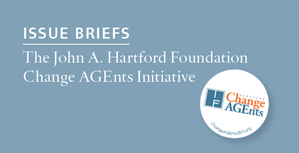 This is the fourth in a series of seven issue briefs.
This is the fourth in a series of seven issue briefs.The John A. Hartford Foundation Change AGEnts Initiative accelerates sustained practice change that improves the care of older adults. It does this by harnessing the collective power of The John A. Hartford Foundation’s interprofessional community of scholars, clinicians, and health system leaders.
In December 2015, nearly 100 John A. Hartford Foundation Change AGEnts gathered in Philadelphia, PA to identify challenges and opportunities for improving care of older adults in several care settings and issue areas. Each group worked toward identifying actionable areas for John A. Hartford Foundation Change AGEnts, the Foundation, and colleagues in the field to pursue. The brief below represents the summary of the Primary Care group’s proceedings and should inform future work to create widespread and systemic changes in the care of older adults.The other issue briefs will be published on Health AGEnda over the following weeks.
Primary Care
 Primary care for older adults, like so much of today’s health care, faces intense cost, policy, and other pressures and is experiencing disruptive and dislocating change. That said, the rise of accountable care organizations (ACOs), patient-centered medical home (PCMH) structures, and other care models dependent on interdisciplinary teams and integrated electronic health records suggest a conversely hopeful set of possibilities for improving primary care, perhaps dramatically.
Primary care for older adults, like so much of today’s health care, faces intense cost, policy, and other pressures and is experiencing disruptive and dislocating change. That said, the rise of accountable care organizations (ACOs), patient-centered medical home (PCMH) structures, and other care models dependent on interdisciplinary teams and integrated electronic health records suggest a conversely hopeful set of possibilities for improving primary care, perhaps dramatically.
For example, this dynamic environment may drive:
- Greater care coordination and transitional supports across health care settings and silos;
- The advent of serious consideration of person-centered care in primary care redesign (e.g., The John A. Hartford Foundation’s Carealign project); and
- The maturation of a whole range of evidence-based care models that can be used in primary care (e.g., the Stanford Chronic Disease Self Management Program, Enhance Fitness and Enhance Wellness, and several proven approaches to geriatric syndrome management around falls, incontinence, and others).
 Challenges
Challenges
The Primary Care Issue group participants themselves represented one of the central challenges of working in this setting. Primary care practitioners (PCPs) and their teams, regardless of organizational structures (i.e., ACO, PCMH, traditional fee for service, etc.), or practice setting, have one central thing in common: They are responsible for the full spectrum of medical care for each of their patients, from wellness and prevention to chronic care and acute care. It is a very tough job, and it seems to be getting harder from the perspective of many primary care clinicians.
The Primary Care Issue group was made up of researchers, some of whom practice in clinical settings; academics/educators; and administrators in healthcare systems and community organizations focused more generally on improving the care of older adults. For the most part, most PCPs and John A. Hartford Foundation Change AGEnts live in very different worlds.
Change AGEnts are often in a position to focus on making system change in organizations, and hopefully partner with PCPs to improve older adult care. PCPs, if they are not focused solely on pediatrics or obstetrics, are geriatric practices by default. Their patients are growing older with more chronic conditions and psychosocial needs, more serious acute illnesses and care coordination requirements. And yet, to meet practices’ and systems’ bottom line, PCPs have to maintain a schedule that books patients at 20-minute intervals.
Looking ahead, practice change in primary care, therefore, cannot be “us” (i.e., Change AGEnts, organizational leaders, advocates, etc.) changing “them” (i.e., PCPs, clinicians). We must create innovations that add value, not simply for health systems or payers, but that help PCPs do their very difficult jobs more effectively and efficiently. Including the practitioners and their points of view in our change efforts may even ensure that new care improvements are more readily adapted and used.
Additional Challenges
Further barriers to practice change in primary care may also revolve around several factors:
- Workforce. The health care workforce, from the front line of clinical care to the C Suite, is not adequately trained in geriatrics, and there is no immediate way forward to fill this gap. Further, those who are educated in the care of older adults too often leave the field due to the difficulty and poor pay/support for these jobs.
- Difficulty translating research into practice. There has been much good work done by members of The John A. Hartford Foundation Change AGEnts community and others, but it has been difficult to spread widely for a variety of reasons, including ‘intellectual property’ issues.
- Barriers to teamwork. Team care in primary care is challenging, and there are analogous difficulties (e.g., time, payment, ownership) in practice change that require cooperation/coordination across primary care practices, health plans, academia, and the community.
- Lack of connection to “natural” partners. Public health systems and departments, for example, don’t have a geriatric focus. Emergency and first responder systems (e.g., police/fire/EMTs) are in daily contact with older adults, but are not integrated into primary care for our population.
 Opportunities
Opportunities
Looking ahead. Many of the pieces of ideal primary care for older adults, including interdisciplinary teams, workforce preparation, person-centered care, community connections, etc., are well known (and have been supported by The John A. Hartford Foundation). What is needed is a way to pull these various aspects into a single, comprehensive resource, a change playbook of sorts that would guide Change AGEnts/primary care advocates and clinician partners in creating transformative change. This would include developing an overarching vision for geriatrics-informed primary care and creating both a shorter and longer-term strategic plan for transforming the field.
Some of the parts of this playbook or guide might include:
- Clear descriptions of the key elements of an ideal primary care practice with good geriatric care, including care approaches, staffing levels, competencies, organizational and technological requirements, community connections, and reimbursement and financial guidelines. This would include associated metrics to help practices understand where they stand against the ideal and shape further improvement.
- Workforce development, geriatric training, and other incentives focused on education and retention of the entire multi-disciplinary primary care team. This would include strategies to ensure that everyone is paid for and practices at the maximum level of her or his licensure.
- Close attention to staff diversity issues, including age/race/sex/sexual orientation/culture/ education and other psychosocial parameters.
- Identification of opportunities to affect state and federal policy, including workforce development, payment, research, quality, safety measures, and other issues. Similarly, close attention to developments at CMMI and PCORI to help practices learn the latest in innovative approaches to providing high-quality, person-centered, geriatric care.
- Tutorials/mentorship in developing:
- The business case for better primary care, including associated value propositions (return on investment) and how to get your business case in front of the right person.
- Common outcome measures for quality care.
- Leadership skills for driving change and how to become a thought leader/expert with community credibility.
- Public relations campaigns to educate the public and affect the community’s perceptions of quality primary care.
- Use of the growing number of retirees (particularly from health care and related professions) and older persons in general as mentors to PCPs, integrating them into practice change efforts and high-functioning practices, as well as ensuring that the voices of older people are included in the design and redesign of primary care.
Working together
A playbook only works if everyone is on the same page, knows what they need to do, and performs at a high level. It is going to take all that and more to bring together all of the players in our health care system to form a cohesive team working to improve primary care of older adults. The components outlined above, however, represent a strong start.
Primary Care Issue Group Participants
Christine Fordyce, MD (Senior Respondent)
Group Health Senior Caucus
Marcus Escobedo, MPA (Facilitator)
The John A. Hartford Foundation
Christine Gherst, MSW (Notetaker)
SCP
Claudia J. Beverly, PhD
University of Arkansas for Medical Sciences
Melissa Dattalo, MD
William S. Middleton Memorial VA Hospital
University of Wisconsin
Nancy Dudley, RN, MSN, MA
University of California, San Francisco
Jessica Esterson, MPH
Yale University School of Medicine
Susan Gilster, PhD, RN
The Gilster Group
Judy Howe, PhD, MPA
Icahn School of Medicine at Mount Sinai
Bronx VAMC GRECC
Korey Kennelty, PharmD, PhD, MS
William S. Middleton VA Hospital
University of Wisconsin, Madison
Christine Liu, MD MS
Boston University School of Medicine
Toni Miles, MD, PhD
University of Georgia
Aanand Naik, MD
Michael E. DeBakey VA Medical Center
Baylor College of Medicine
Maria Oquendo-Scharneck
AgeOptions
Kate Queen, MD
Mountain Area Health Education Center
Carol Regan, MPH
Community Catalyst
Robert Schreiber, MD
Hebrew SeniorLife, Department of Medicine
Tasha Woodall, PharmD
Mountain Area Health Education Center
Jean Wyman, PhD, RN
University of Minnesota
Phyllis Zimmer, MN, FNP, FAANP, FAAN
Healthcare Foundation
Read the previous posts in The John A. Hartford Foundation Change AGEnts Issue Briefs series:
End of Life and Serious Illness
